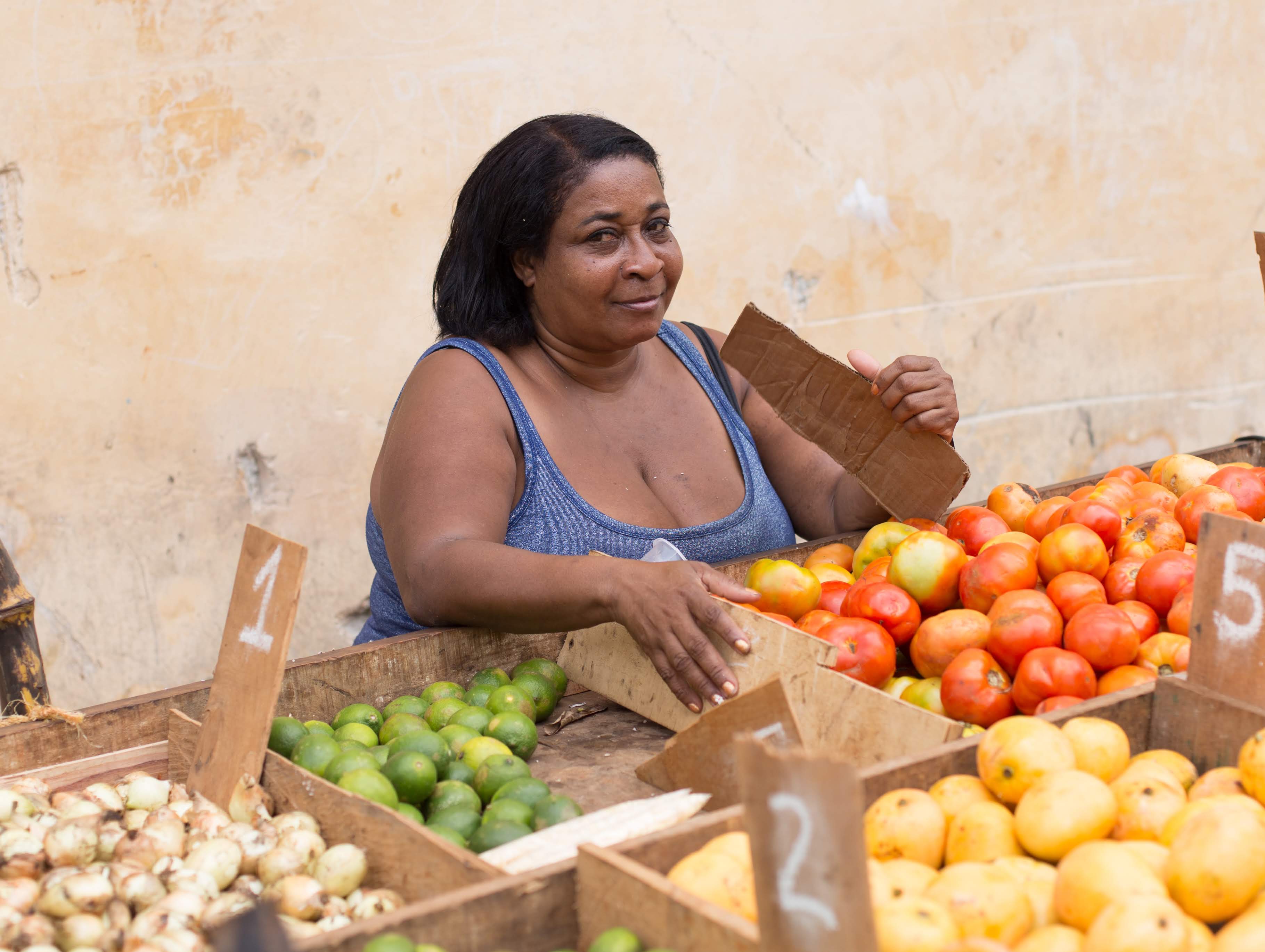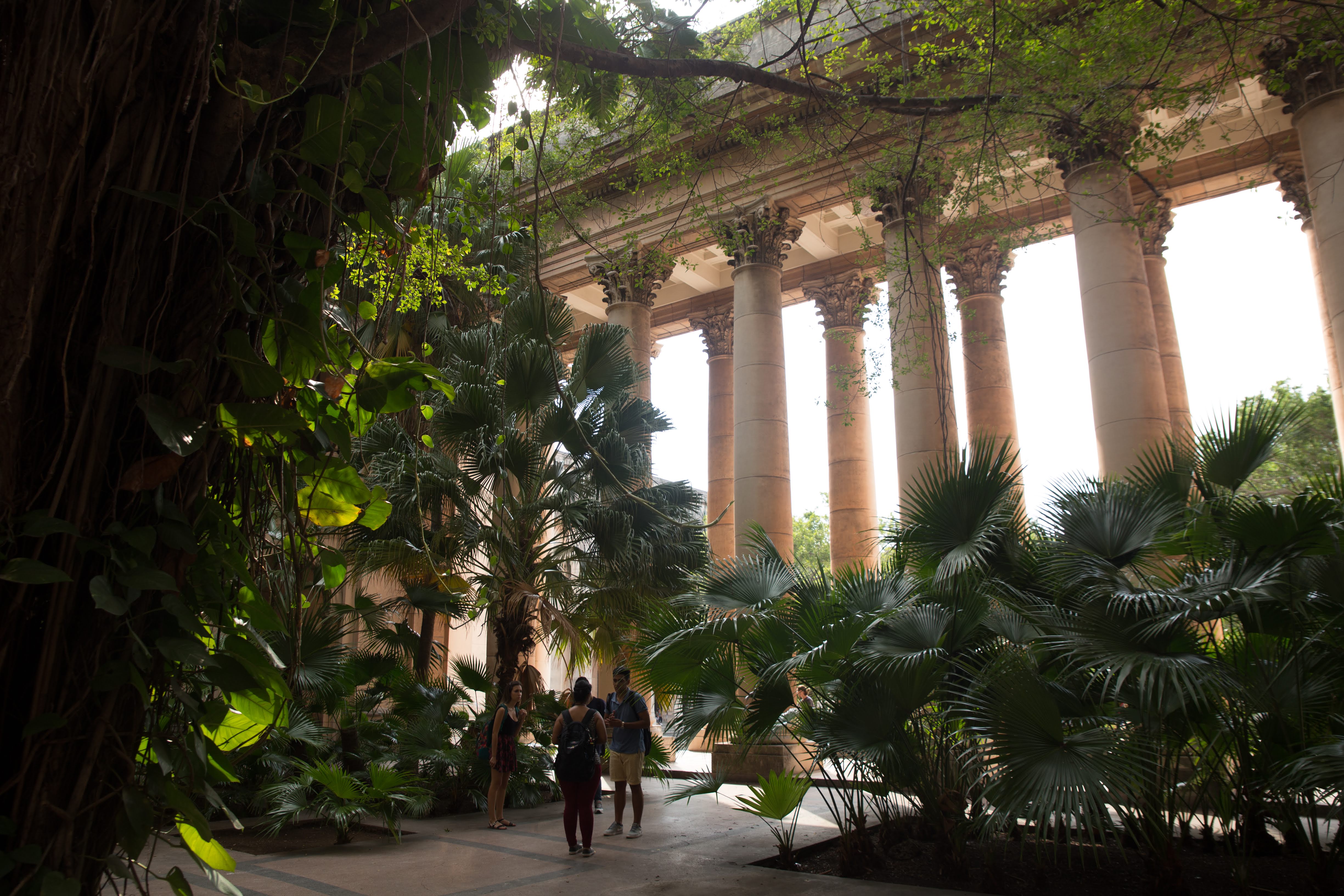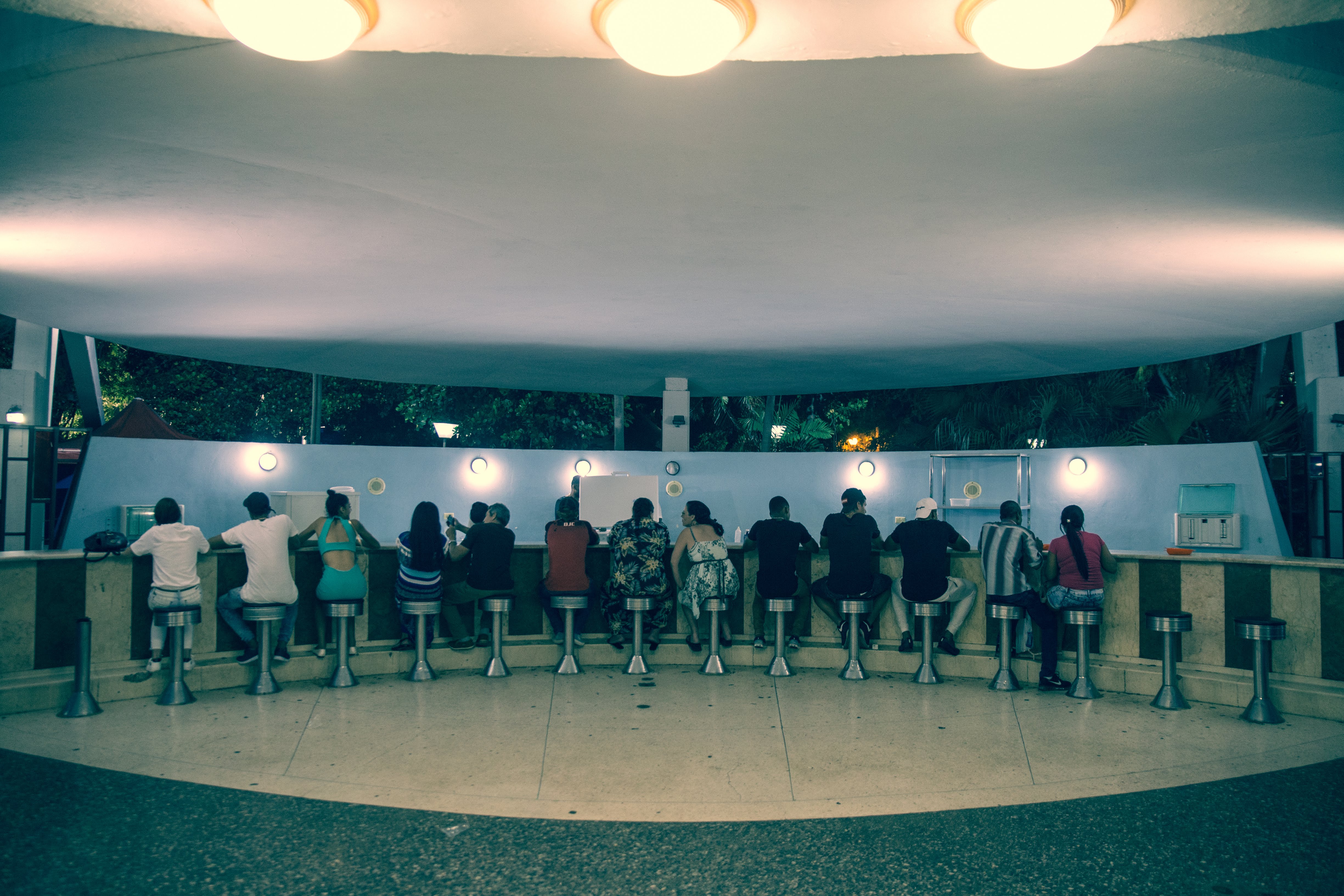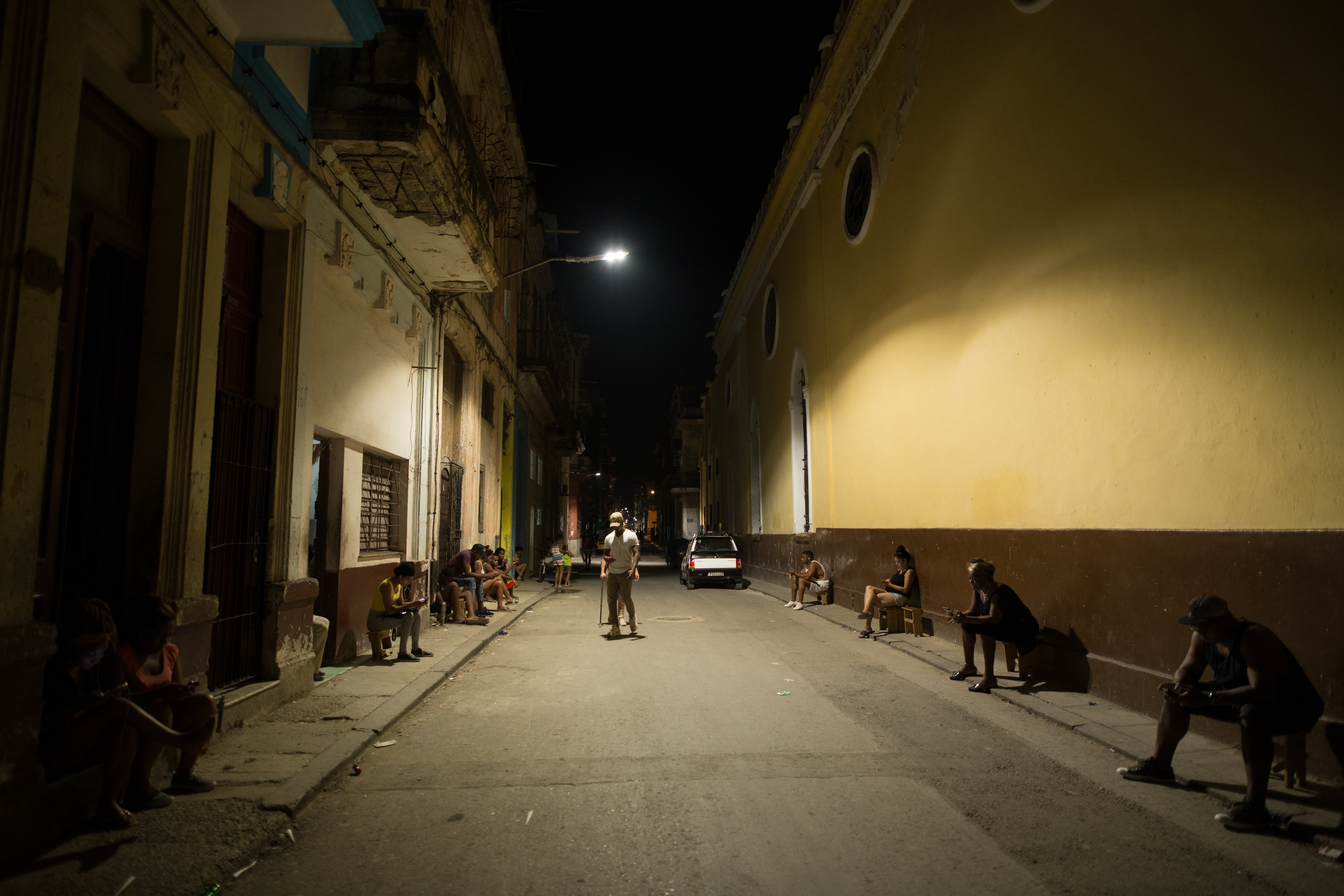A day using money in Cuba
Ira wakes up craving some eggs for breakfast. She walks under the strong Cuban sun and visits the food market . She’s lucky: they have eggs today.
“How much for the box?” she asks, pointing at the box of 30 eggs.
“Four pesos”
She looks in her purse and finds a 100 peso note. She hands the note to the seller, who nods and hands her the eggs. She leaves without getting any change, nor did she expect to.
Cuba is a puzzling country, especially when it comes to money. Like Yemen, it has an oddly bifurcated monetary system. But this is not the result of a civil war, nor a recent phenomenon: the Central Bank of Cuba has been issuing two different kinds of pesos for decades now.

Woman selling produce in Old Havana (2019). She expects you to know what peso the prices are in.
The Cuban peso (CUP) is the national currency (moneda nacional) of Cuba, which traces its origins back to the colonial pesos of the Spanish empire. It has been pegged to the US dollar since 1881, with an intermission between 1960 and the 1990s, when it was pegged to the Soviet ruble. Nowadays, the official exchange rate is 25 CUP for 1 USD.
The Cuban Convertible Peso (CUC) is another official currency, first issued in 1993 with the aim of taking USD bills out of circulation. It is pegged 1:1 to the dollar. The government has intended to withdraw the CUC from circulation for years to remove the constant friction of having to convert between two currencies, but it hasn’t yet taken the decisive step. In recent months, many Cubans seem to have lost trust in the CUC peg, which has led to the reappearance of US dollar bills in informal markets.
In our story above, the seller quoted Ira 4 CUC (officially worth 4 USD), and she paid with a 100 CUP note (also worth about 4 USD). Confusingly, both currencies are often just called pesos. Cubans are often guess the currency they’re quoted in and do the conversions in their heads, but the dual system definitely demands more work from its users.
Context: Havana Hilton to Hotel Tryp Habana Libre
 Traffic in front of the Habana Libre, formerly known as the Havana Hilton (2019)
Traffic in front of the Habana Libre, formerly known as the Havana Hilton (2019)
While enjoying her eggs, Ira hears her doorbell ring. It’s the Airbnb man, who has come to pay her for her tour guides! This truly is her lucky day: the man is usually a few weeks late. Excited, she receives an unmarked envelope with her money and thanks the man.
Airbnb offers two methods of payment in Cuba. Option A is a MasterCard from Payoneer that’s rumored to work intermittently, costs 30 USD a year, plus 1% per transaction, plus 5% in ATM fees… Option B is through “the Airbnb man” that really works for VaCuba, a company that doesn’t officially exist in the country and doesn’t provide guarantees on timely payments. Almost all Cuban Airbnb hosts choose this option.
Ira knows that in most other parts of the world a company like Airbnb wouldn’t send an anonymous man with an envelope to pay her. But Cuba is not like most parts of the world. She’s glad Airbnb even lets her work on their site: most other sites, like PayPal, expressly ban Cubans from opening an account. Other sites on the internet simply pretend Cuba doesn’t exist. When selecting your country of residence, the dropdown menu shows Costa Rica, Croatia, then Cyprus – Cuba is not even an option.
Cuba’s arcane dual currency system cannot be understood without a quick overview of Cuban history. Today, Cuba’s economy is shaped by Marxist central planning and US sanctions. It is one of the smallest economies in the Americas. It wasn’t always like that.
In the 1950s, Cuba had more in common with US states like Louisiana and Florida than Hispanic countries like Mexico and the Dominican Republic. Cuban income per capita exceeded Mexico’s by 70% and the Dominican Republic’s by 300%. Its income per capita was even greater than that of ex-colonial powers Spain and Portugal. A symbol of Cuba’s mid-century oppulence was the Havana Hilton:
Latin America’s tallest and largest hotel. It boasted 630 guest rooms, including 42 suites; an elegant casino; six restaurants and bars, including a Trader Vic’s and a rooftop bar; a huge supper club; extensive convention facilities; a shopping arcade; an outdoor pool surrounded by cabañas; and two underground garages with a capacity of 500 cars.
The grand opening featured a vast array of Hollywood celebrities. Behind the scenes, the American Mob controlled the casino, in the same way the Mob controlled much of the lucrative gambling and prostitution in Havana.
The grand opening of the Havana Hilton was in March 1958. Nobody attending could have guessed that Che Guevara would move in next January. The Cuban Revolution had started in the poor east of the country and culminated with the capture of wealthy Havana. Cuba eventually started following the Soviet model of a centrally planned economy.
Following the revolution Cuba lost its main trading partner: the United States. The first ban on US exports to Cuba was imposed in 1960, after all private companies in Cuba, including many American ones such as the Havana Hilton, were expropriated. The Havana Hilton became the Habana Libre (free Havana in Spanish). Since then, US sanctions have attempted to limit the ability of the Cuban state of engaging in international trade. The Helms-Burton Act of 1996 explicitly restrains non-US companies from trade with Cuba.
The loss of the US as a trading partner in the 1960s was counterbalanced by a new, generous partner: the Soviet Union. In the 1990s, when the Soviet Union imploded, Cuba again lost its main trading partner.
The Soviet collapse was devastating for Cuba. Euphemistically named the “Special Period”, the country got close to famine. GDP dropped around 35% in four years. Inflation was rampant. By some measures, domestic consumption never recovered to pre-1990 levels. Nonetheless, there was a sustained period of recovery from 1993 to 2000 thanks to economic reforms which incorporated market elements. Private businesses were allowed for the first time (to a limited extent), and foreign investment was encouraged. The management of the Habana Libre was handed over to Spanish hotel chain Meliá Hotels International (risking lawsuits due to US sanctions). The hotel became officially known as the Hotel Tryp Habana Libre.
As of publication the Habana Libre is empty.
Cuban Peso vs Cuban Convertible Peso

Soviet Style High Rise Buildings in Havana (2019)
After her breakfast, Ira is headed to University of Havana, where she’s a student of Russian language and literature. One time one of her classmates circulated a note with old Soviet jokes. Her favourite one was:
“We pretend to work, and they pretend to pay.”
Old Soviet jokes are not that out of date in 2020 Cuba. As a student, she receives a scholarship from the government of about 50 Cuban pesos (CUP) every month. This is roughly 2 dollars a month, enough for about 15 eggs.
A few blocks away from the university, Ira sees a large crowd patiently waiting in front of the state-run bodega. She asks a passerby why.
“Dicen que hay pollo.” (They say there’s chicken). The crowd is there to buy state-subsidised chicken meat. Rationing books used to have a provision for fish. Then the fish ran out and it was substituted with chicken – “pollo por pescado”. Now the chicken has gone missing too. It was sourced from Brazil, and had become scarce at state stores since Jair Bolsonaro was elected and reduced exports to Cuba.
Ira walks past the crowd. She does not buy anything at state rationing stores, first, because she cannot be bothered to stand in line all day. Second, because even though she lives and studies in Havana, she is legally domiciled in Matanzas and isn’t allowed to shop elsewhere. Her mother gets her rations for her in her hometown.
This historical context provides the background as to why Cuba has two currencies. As a reminder, these are the Cuban peso (CUP) which is the national currency (pegged 25:1 to the USD) and the Cuban Convertible Peso (CUC), which is the “foreign” national currency (pegged 1:1 to the USD).
After the Soviet collapse, during the “Special Period” when people across the country went hungry, inflation struck. The street rate of the CUP suffered an intense devaluation, going from 5 CUP per USD in 1989 to 150 CUP per USD in 1993. Accepting the realities of inflation, owning foreign currencies was legalised in 1993. The US dollar started circulating freely. It became possible to open US dollar deposits. The economy started to dollarise. By some estimates, half of economic transactions were made in US dollars, similarly to current-day Venezuela. The CUC was also first issued in 1993, supposedly backed by an equal amount of US dollars in the Cuban Central Bank.
After 10 years of dollarisation, the government made an effort to de-dollarise in 2003. First, the dollar was substituted by the CUC in state enterprises. Dollars in circulation were gradually replaced by CUC, and finally the USD deposits were converted to CUC. Cubans and visitors alike were forced to convert their dollars into CUC before using them. USD transactions were taxed. In one year, foreign currency entering Cuba went from being 80% in USD to 30%. The CUC, which had been circulating in the population since 1994, replaced the USD in the Cuban economy. US dollars that were previously held by the population ended up in the reserves of the Cuban Central Bank. In the words of Cuban economist Pavel Vidal:
The CUC made it possible to recover monetary policy autonomy and it was seen as a transition towards a future monetary unification.
The dual currency system was a scheme devised to de-dollarise the economy. But what does this mean in practice for a population that has to deal with two different national banknotes?
A Two Tiered Economy
 Students at the University of Havana (2019). Tuition is free for Cubans, professors get paid in CUP and foreign students pay tuition in CUC._
Students at the University of Havana (2019). Tuition is free for Cubans, professors get paid in CUP and foreign students pay tuition in CUC._
Ira walked towards a crowded bus stop heading to Central Havana. The trip costs 0.40 CUP (approx 0.016 USD), payable to a bus driver who isn’t keen on giving change. To pay the exact fare, one must use 0.20 CUP coins, which are hard to come by. One can still get them in banks after enduring queues for hours. Since fares were hiked in 2019, she’s seen more and more pensioners by the bus stops ready to exchange four 0.20 CUP coins for a 1 CUP coin and make a 20% profit.
Ira decides not to take the crowded bus, flags down a 1950s car and sits in the front, next to the driver and another passenger. The driver doesn’t even look at her and says:
“Es a peso”
The driver meant she had to pay 1 CUC (or 25 CUP) for the ride, more than the usual 10 CUP. This was not entirely new. Drivers raised prices after the new transport laws of 2019 and the lack of fuel coming in from Venezuela. It was slightly unusual for them to charge this much in these hours, but she was late and not in the mood to haggle. So they went.
The Cuban economy can broadly be segmented into two: the official economy (which mostly runs on CUP) and the unofficial economy (which mostly runs on CUC, especially in tourism-related activities). A reminder: The CUP is the national currency, it is pegged 25 to 1 to the US dollar and its banknotes display Cuban revolutionaries such as Camilo Cienfuegos and Che Guevara. The CUC was invented in 1993 as a measure to de-dollarise the economy, is pegged 1:1 to the US dollar and displays monuments on its banknotes.
The majority of the population is employed by the state. The state pays salaries in CUP. The official median monthly salary in Cuba in 2018 was 777 CUP (approx 31 USD). Official Cuban salaries are virtually impossible to survive on, as demonstrated by the documentary La singular historia de Juan sin Nada. Many Cubans feel that they have an implicit social contract with the state where salaries may be low, but the state will provide for all their basic needs at a very subsidised price (“we pretend to work, they pretend to pay”, remember?).
When Cubans pay the state or state-run companies for “non-luxury” goods, such as utilities and transport, they pay in CUP. The more distant the good is from the influx of foreign money, the more likely it’s sold in CUP – people in remote towns pay almost exclusively in CUP.
However, subsidised goods are often of bad quality and difficult to obtain. Buses are crowded. Rationing is common. Often, people stay afloat by spending more than they officially earn. Many people have an official job only so they qualify for state subsidies, and a “side-hustle” that is what actually makes them money. Some Cubans effectively have negative salaries: people sometimes bribe their boss so that they do not have to show up. This way they can work at their income earning hustle all day. An employee for a government owned company might spend the morning working at her official job for CUP (and to keep enjoying state subsidies), and the afternoon selling souvenirs to tourists for CUC.
People that earn CUC spend on “luxury” goods. The Cuban government wants payment in CUC for emitting a passport. State run bakeries sell bread for 1 CUP, whereas the cooperative run bakery called El Biky sells much better bread for 1 CUC. Tourists, expats and wealthy residents buy at El Biky.
This does not mean that places that quote prices in CUC won’t accept CUP or vice-versa. A taxi driver that quotes 1 CUC for the ride will likely take CUP, but there are some unusual exchange rate conventions. Coins are worth less than you would expect. For example, two 0.5 CUC coins are worth 20 CUP, but a 1 CUC bill is worth 25 CUP. People also combine the two currencies for convenience. For instance, if you have to pay 5 CUC you can pay with a 100 CUP note and a 1 CUC coin.
 Cubans enjoying a 2 CUP ice-cream in Havana (2019). Tourists are not allowed to sit with them and must pay (more) in CUC.
Cubans enjoying a 2 CUP ice-cream in Havana (2019). Tourists are not allowed to sit with them and must pay (more) in CUC.
Whether you pay in CUC or CUP depends not only on the goods and services you are buying, and who you are buying it from, but also on who you are. The most obvious example is the fact that tourists are often asked to pay the face CUP price in CUC (25 times the price!). Hence, a 2 CUP (0.04 USD) Coppelia ice cream will cost a tourist 2 CUC. Those who are well connected and can trade favours can buy things for CUP that others can only access in CUC. This can happen on a personal level (e.g. a well connected individual can fly out of Cuba paying a few hundred CUP on Cubana de Aviacion), but is an established practice at the enterprise level.
Exchange rates and CUC devaluation
 The Cave Club in Trinidad (2019). Only CUC accepted.
The Cave Club in Trinidad (2019). Only CUC accepted.
When she got home, Ira got to work. She recently found a new job as an online content writer in Russian. She’s had to look for online jobs since the tourism industry is in crisis. Her Russian boss couldn’t find an easy way to send money to Cuba, so she gets paid in bitcoin.
She only gets a few hundred dollars a month from this job, but she found a way to make it work quite well. The state owned telecommunications company, ETECSA, runs promotions where if you top up your mobile phone online you get extra credit. This is designed to get hard currency from the emigrated Cubans who will top up the phones of their families so that they can talk. The promotions are quite good, so many Cubans that do not have friends and family abroad will pay middlemen cash to top up their phones from abroad.
She discovered that she can use bitcoin to top up people’s phones on bitrefill.com, and she can charge for this. For every 100 dollars she receives in bitcoin, she gets 120 CUC in cash from her friends whose phones she tops up. Ira is quite pleased that she has found to a way to arbitrage the currency exchange. If she got paid via Western Union, she’d lose 15% of what the agency pays her. This way, she makes 20%.
The Cadeca (Casa de Cambio, state run money exchange) sells 1 CUC for 25 CUP and buys 1 CUC for 24 CUP. This is the rate the population is used to dealing with. Often private shops will set the CUC rate at 25 for convenience, but taking CUC at 24 is also common and some small shops even take it at 23.
However, that is not the only exchange rate. One of the biggest difficulties for the Cuban government faces in getting rid of the CUC are the multiple exchange rates. Exchange rates have become a method for state run companies to extract wealth by creating arbitrage opportunities at the expense of foreign investors and/or the population.
The economist Armando Nova has compiled a few of the valid exchange rates in Cuba:
- Azcuba (the Cuban state run sugar company), exchanges CUC and CUP at a 1:2 rate for fuel purchases
- Azcuba uses 1:3 rate for some other (non-fuel) purchases
- According to a resolution of the Ministry of Finance and Prices the sale of food to the tourism industry is done at a rate of 1 CUC = 9 CUP.
- In the special economic zone of Mariel salaries are paid such that 1 CUC = 10 CUP.
- Other foreign investment companies must pay salaries with the exchange rate of 1 CUC = 2 CUP.
Several Cuban economists have pointed out that this practice has obfuscated the real performance of these state owned companies and in turn the entire economy. The reason that the government has hesitated to withdraw the CUC is that it would mean converting all of it to CUP, which depending on the exchange rate used might cause the bankruptcy of several large state owned companies.
Yet, many measures taken by the government in the last 12 months have devalued the black market rates of the CUC. While the CUC traded informally at 0.97 cents vs the USD in summer of 2019, it was trading at 1.10+ in early 2020. The catalyst has been the introduction of MLC shops and the steps the government is taking to limit the venues where CUC is accepted. But it has become increasingly clear that the growing issuance of CUCs since 2004 has not been backed by US dollar reserves. In the words of Pavel Vidal:
The disproportionate issuance of CUCs, the subordination of monetary policy to the fluctuations and excesses of public spending, and the lack of transparency, gradually undermined the convertibility and credibility of the CUC.
MLC shops are government run venues where individuals can purchase imported goods ranging from air conditioners to cars (a Toyota Land Cruiser costs 80k USD). The way it works is that consumers “top up” their MLC account with foreign currency (EUR, USD, etc.) and can spend it at the shops. While the prices in the shops are high compared to those abroad, they are more competitive than those previously offered by Cuba’s informal private importers. This has led to many people selling CUC for foreign currencies on the black market to buy goods in the MLC shops, leading to the devaluation of the CUC. Furthermore, salaries in CUP in the state sector have been raised significantly, which has led to inflation in prices of consumer goods. Leading to more demand for foreign currencies.
Moreover, the government is limiting the venues that take CUC. Many institutions and individuals have seen the writing on the wall and have concluded that the CUCs days are numbered and will no longer accept it. For example, the International School of Havana, where the children of diplomats and other expats study, no longer accepts CUC for its tuition. This uncertainty is a strong incentive for people to get out of CUC, increasing the demand for foreign fiat currencies but also cryptocurrencies. Bitcoin trades at a 15–20% premium (e.g. if the Bitcoin spot price is 10k USD, Cubans will pay 11.5k–12k CUC for it).
What is next for money in Cuba?
 Wifi corner in Central Havana (2019).
Wifi corner in Central Havana (2019).
Cuba’s government faces a unique set of challenges in managing the economy. US sanctions continue to bite. Keeping up the dual currency system is costly but getting rid of it will create huge upfront costs. The loss of Venezuela as a powerful backer has caused severe problems in the economy. The Coronavirus pandemic has decimated the important tourism industry. The growth of a competitive private sector is essential for the sustainable development of the economy, yet Cuban entrepreneurs face financial censorship both from their own government, and that of the United States.
US sanctions make bottom up dollarisation less attractive than in other Latin American countries. The Cuban sanctions programme is the oldest, largest and most comprehensive American sanctions programme. In theory, the official American policy is to encourage private entrepreneurship in Cuba as a way of helping civic society develop on the island. In practice, a Cuban entrepreneur will find it difficult to participate in the global economy due to US sanctions. The regulatory headache that is dealing with Cubans leads to overcompliance that cuts all Cubans out. The embargo is entrenched and heavy handed: Chinese billionaires struggle to donate medical equipment in a pandemic. Cuban entrepreneurs are routinely devastated by it.
During the Obama administration the US government started easing sanctions on Cuba. The Cuban government eased restrictions on private enterprise. President Obama visited the island. For many Cubans, particularly those working in tourism, these were boom years. Tourists flooded Cuba, including celebrities such as Beyonce and Rihanna. With them came foreign investment. This all changed with the election of Donald Trump. The new administration reversed much of the previous administration’s Cuba policy, and enacted powerful new sanctions. Significantly fewer tourists came in 2019, and the 2020 pandemic has shut down tourism altogether. Fuel shortages are now common. The government has responded with price controls and stepping up the repression.
Overall, the last 12 months have been some of the most difficult for the Cuban economy in recent memory. Many talk of a return to the Special Period of the 1990s. The year 2020 may end up being a year of great changes in Cuba: if the government does indeed withdraw the CUC, there might be a severe devaluation of the CUP. In fact, there may be a devaluation of the Cuban money no matter what the government does. Not many expect Venezuelan style hyperinflation, but there is a growing appetite for US dollars in the black market. Food is already scarce. Several experts think dollarisation is imminent. Many Cubans fear a repeat of the Special Period of the 1990s. The question is: can Cuba avoid this, and if not, will Cubans stoically accept another Special Period?
Further Reading
On the Cuban economy, Cuban economists Oscar Fernandez Estrada, Pavel Vidal, Pedro Monreal and Armando Nova. This essay would not be possible without them, particularly Pavel Vidal’s PhD thesis.
The Juan Sin Nada documentary does an excellent job at explaining the economics of Cuban consumers (albeit in Spanish).
On Cuban history, I recommend Hugh Thomas’ excellent book and the History of the Cuban Revolution podcast. For more on the extensive role of organised crime in pre-revolutionary Cuba: Havana Nocturne.
Thanks to Bianka Csenki for the photography and to Alejandro Machado for proofreading and ideas.